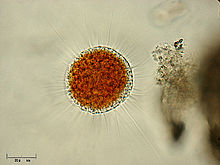Vampyrellidae
Appearance
You can help expand this article with text translated from the corresponding article in French. (June 2019) Click [show] for important translation instructions.
|
| Vampyrellidae | |
|---|---|

| |
| Vampyrella lateritia | |
| Scientific classification | |
| Domain: | Eukaryota |
| Clade: | Diaphoretickes |
| Clade: | SAR |
| Phylum: | Endomyxa |
| Class: | Vampyrellidea |
| Order: | Vampyrellida |
| Family: | Vampyrellidae Zopf, 1885 |
| Genera | |
| Diversity | |
| 19 species | |
The family Vampyrellidae is a subgroup of the order
Aconchulinida) within the supergroup Rhizaria.[1][2] Based on molecular sequence data, the family currently comprises the genus Vampyrella, and maybe several other vampyrellid amoebae (e.g. Gobiella).[2] The cells are naked and characterised by radiating, filose pseudopodia (also referred to as filopodia) and an orange colouration of the main cell body.[3][4]
In former times the family Vampyrellidae contained several genera (e.g. Theratromyxa.[2]
Characteristics

When free-floating, the cell is spherical and around 30 μm across, with long radially directed filose pseudopods as well as distinctive shorter club-shaped ones, so that it resembles a
fungi. As such, these vampyrellids can be an important control of parasitic rust fungus of wheat
and other crops.
Vampyrellids characteristically have
nucleariids they include the majority of the naked filose amoebae.[citation needed
]
Systematics and phylogeny
Genera and species
There are at least 19 credibly described
species that are either proved or likely to belong to the family Vampyrellidae, all of them belonging to the genus Vampyrella.[7]
- Vampyrella Cienkowski 1865. 19 species.
- Vampyrella agilis Penard 1890
- Vampyrella atheyae Zyloff 1903
- Vampyrella closterii Poisson & Mangenot 1933
=Gobiella closterii Röpstorf et al. 1994 - Vampyrella euglenae Dangeard 1886
- Vampyrella flabellata Cash 1904
- Vampyrella gomphonematis Haeckel 1870
- Vampyrella helioproteus Engelmann 1882
- Vampyrella incolor de Bruyne 1890
- Vampyrella inermis Klein 1882
- Vampyrella lateritia (Fresenius 1856) Leidy 1879
= Amoeba lateritia Fresenius 1856
= Vampyrella spirogyrae Cienkowski 1865 - Vampyrella mirabilis Dangeard 1935
- Vampyrella multiformis Zopf 1885
- Vampyrella pallida Moebius 1888
= Vampyrina pallida (Moebius 1888) Frenzel 1897 - Vampyrella peritrichophaga Dangeard 1886
- Vampyrella polyblasta Sorokin 1876
- Vampyrella radiosa Penard 1890
- Vampyrella soror Shouteden 1905
- Vampyrella ulothricis Scherffel 1935
- Vampyrella variabilis Klein 1882
Phylogenetic tree
The following cladogram depicts the relationships between Vampyrellidae and other vampyrellid families. Of the 19 species, only 2 species of Vampyrella have been genetically sequenced, which limits the information on the internal relationships of the genus.[7]
| Vampyrellida |
| ||||||||||||||||||||||||||||||||||||||||||
References
- ^ "Vampyrellidae". Retrieved 2009-03-08.
- ^ PMID 22355342.
- S2CID 84323025.
- ^ Zopf, Wilhelm (1885). Die Pilzthiere oder Schleimpilze. Breslau: Trewendt.
- PMID 18952499.
- ^ Morphology and fine structure of the trophozoites of Theratromyxa weberi (Protozoa: Vampyrellidae) predacious on soil nematodes
- ^ S2CID 245303468.
External links
- Röpstorf, Peter; Hülsmann, Norbert; Hausmann, Klaus (1994). "Comparative fine structural investigations of interphase and mitotic nuclei of vampyrellid filose amoebae". S2CID 84357480.
- http://starcentral.mbl.edu/microscope/portal.php?pagetitle=assetfactsheet&imageid=932
- http://tolweb.org/tree?group=The_other_protists&contgroup=Eukaryotes
Wikispecies has information related to Vampyrellidae.
